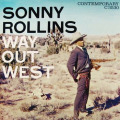Rifftides: October 2009 Archives
In his blog I Witness, Ed Leimbacher muses about the pervasiveness of Thelonious Monk as a model for or influence on other pianists. In an essay packed with album citations, he acknowledges 18 pianists from Jelly Roll Morton to Keith Jarrett who have made an impact, then writes:
... but I still think that over the last half century Monk has outlasted and out-"performed" the competition. Why? Relatively straightforward numbers like "'Round (about) Midnight" and "Monk's Mood" have entered the playbooks of most Jazz pianists and many small groups, in contrast to his obscurities like "Shuffle Boil" or "Green Chimneys." But even the obscure tunes have their day on some Monk tribute or another (one fan has compiled a list of 60 such albums).
And the irregularity, angularity, repetition, broken tempos, scattered notes, strange chords, surprising melodies--whatever one hears or singles out among Monk's keyboard habits--seem magnetically to attract other pianists' fingers. "Shall I prove I can mock Monk effectively, or shall I offer a new interpretation?" That's the choice facing every pianist (or guitarist, or saxman, or vocalist) contemplating one of his compositions, and all options are to be heard somewhere.
After discussing several pianists and a singer (Carmen McRae), Leimbacher concludes his essay on Monk's sway with a paean to a big band arranger's CD, Brilliant Corners: The Music of Thelonious Monk by Bill Holman. He says that Holman "takes off the gloves, grabs hold of Monk's melodies, pokes and prods and stretches them into new skewed shapes." To read Mr. Leimbacher's piece, go here. To comment, use the link below.
Reviewing the Art Farmer Jazz Icons DVD the other day stimulated thoughts of his unique place in the pantheon of major jazz soloists. I started to write them, then realized that I already had. Here is an excerpt from the Farmer chapter of my book Jazz Matters.
Even on some of Farmer's first recordings in the early 1950s it was clear that he was a first-rank soloist in the making. By 1956 Farmer's work showed a combination of incisiveness and lyricism that added elegance and style to the bands of leaders as disparate as George Russell, Gerry Mulligan and Horace Silver. Such versatility has long been a matter of inconvenience for writers who need categories like "hard bop" or "cool."Shortly thereafter, Farmer became one of the few contemporaries of John Coltrane who absorbed, understood, and had the technical and artistic gifts to put to personal use the Coltrane innovations of the "Giant Steps" period of the early 1960s. He is virtually the only trumpeter who did so. Many players were swamped by the Coltrane influence. Farmer integrated it into his style and his lyrical range grew because of it.
At about the same time he took up the flugelhorn, that lovely and demanding instrument. When he added the new horn, and eventually set the trumpet aside, the
lovely muted work he had done on trumpet was lost. But the change of instruments accented what critic Richard B. Hadlock called Farmer's "soft edge," the quality that allowed listeners to accept his masterfully played but audacious ideas, passages they would reject as too far out if performed by most other players. He had found the voice that would carry all the impact of his remarkable invention and plumb all the depths of his feeling. And, happily, in a recent collaboration with Jim Hall, Farmer's Harmon mute materialized again after more than fifteen years.
Farmer is a great melodist. He loves and observes the melodies of the songs he plays. They are often surpassed by the melodies he creates. I have rarely heard a Farmer solo sound like the product of reflect processes. In times of flagging inspiration, or in uncongenial circumstances, even the most inventive players fall back on a sort of universal phrase book. But in a recent jazz festival jam session (hardly his preferred context), the clarity and beauty of Farmer's solos remained in memory long after the dissipation of scene-stealing clichés generated by most of the other players. That is artistry.
The chapter from which that came expands on program notes I wrote for a Farmer concert in the Jazz at the Smithsonian series in the early 1980s. Trolling the internet the other day, to my surprise I came upon several pieces of video from that concert. Three of them follow. In the first, he uses a trombone mute that he had a technician alter for use with his flugelhorn. His band has young Fred Hersch on piano, Dennis Irwin on bass and Billy Hart on drums.
"Cherokee Sketches" is faster than fast, with ample evidence of Farmer's absorption of Coltrane harmonic principles into the flugelhornist's bebop foundation. Watch and listen to Hart during Farmer's solo for a living demonstration of what is meant by the term "listening drummer."
Finally, here's Art in brief conversation with the Voice of America's Willis Conover, then playing a classic Duke Pearson ballad. The video is cut before Hersch or Irwin solos, but I'm not sure what they or anyone could have effectively added following Farmer's chorus.
Washington, DC, correspondent John Birchard ventures into the jazz wilds of the US capital in search of live music and reports to Rifftides readers on what he hears. This time, the event was a tribute concert.
CANNONBALL REVISITED
By John Birchard
It could have been 1962. On Saturday evening at Baird Auditorium at the National Museum of Natural History in Washington, DC, a quintet of musicians from the Smithsonian Jazz Master Works Orchestra presented Portrait of Julian "Cannonball" Adderley. The band was headed by the orchestra's lead alto player, Charlie Young, who served as master of ceremonies. Trumpeter Tom Williams played Nat Adderley's parts. The rhythm section was pianist Bob Butta, bassist James King and drummer Ken Kimery.The program concentrated on Adderley's years at Riverside Records, with which he signed following his stint with Miles Davis, and specifically on 1959 through 1961. The
transcribed arrangements came from five LPs ... In San Francisco, Them Dirty Blues, ...At the Lighthouse, ...Quintet Plus and Know What I Mean? The quintet played them as faithful recreations of the charts, but with the present-day musicians' own solos.
This correspondent was a jazz disc jockey during the years in question. I recall the anticipation with which I greeted each new Cannonball Adderley LP. The performances at Baird generated a good measure of the same excitement. Hearing those arrangements again brought back happy memories of the Adderley band. One can argue whether nostalgia is the role jazz should play, but it satisfied the near-capacity crowd of gray-hairs who were no doubt around for the original performances.
The tour of memory lane began with Bobby Timmons's "This Here", the familiar piano intro in ¾ time leading into the equally familiar alto-trumpet blend on the melody. Charlie Young recaptured Julian's overall sound and earthy quality on this and every tune (with one exception) during the evening. The Randy Weston composition "Hi-Fly" came next, followed by Cannonball's own "You Got It", the quintet taking the intricate chart at a blistering tempo. Nat Adderley's popular "Work Song" prompted cheers and applause for the crisp rhythm section work, especially Kimery's drumming. The first half of the concert closed with Adderley bassist Sam Jones's "Del Sasser."
Following intermission, there was a second Bobby Timmons tune - "Dat Dere." Then the quintet explored a couple of pieces from Victor Feldman's time with Adderley, first "Lisa" (from the 1961 recording The Cannonball Adderley Quintet Plus). "Azul Serape"
followed. Both incorporated Latin passages enhancing the tunes' attractiveness. From Cannonball's LP Know What I Mean? featuring pianist Bill Evans, Charlie Young played the melancholy Gordon Jenkins' melody "Goodbye." That's when he departed from homage to Cannonball. Young has spent time with the Duke Ellington Orchestra and it's clear that he has listened closely to the great Johnny Hodges. His approach to the old Benny Goodman closing theme was more Hodges than Adderley. Never mind; it was effective, moving ballad playing.
The evening of rhythmic recollection came to a brisk close with the quintet playing Vic Feldman's "Exodus", not to be confused with the movie theme. All the qualities the SJMO quintet brought to the Adderley charts were in evidence - tight, well-rehearsed ensembles, spirited solos and an enthusiasm for the well-crafted compositions and arrangements made famous by the Tampa Cannonball. If this be nostalgia, our vote's in favor. Later in the year, Freddie Hubbard will be remembered in similar fashion by the Smithsonian gang.
As a video footnote to John's review, here's a mid-1960s performance of one of the tunes the Smithsonians chose from the Adderleys' repertoire. It comes from the Jazz Scene USA television program. Cannonball, alto sax; Nat, cornet; Joe Zawinul, piano; Sam Jones, bass; Louis Hayes, drums. Yusef Lateef, a member of the band at the time, sits this one out. Julian introduces the piece.
A few times you've linked to Amazon listings for Venus releases, such as the Charlap/NY Trio disc in your new set of picks. Just a caveat about this, of which you may be aware. These are CD-Rs with reprinted liner booklets and info. Obviously the price reflects this and Amazon and Venus are to be applauded for offering this important music at a more reasonable price stateside. However, I picked up a Kenny Barron CD recently and the inserts listed nothing but the musicians' names and song selections. There was no recording date nor were there composer credits. As something of a fanatic about this sort of information, it was disappointing. Perhaps there was a translation issue involved. In any event, I wanted to mention this to you.
Rich Juliano
(The Charlap CD is also available from Amazon in the US at the import price of $44.98. In Japan, their country of origin, Venus CDs sell for 2,500 yen; at today's exchange rate, $27.40 US. I did not intend to choose for Rifftides readers, but the $30.99 difference between the import and the CD-R may be attractive to some. -- DR)
Just got the new Anita O'Day Jazz Icons DVD. Loved the DVD and enjoyed your notes. By now you've probably noticed that the "editors" - I assume it was the editors, changed your spelling of June Cristy's last name in the notes to "Christie."
Steve Ramm
(I don't know how that happened. I'm willing to accept the blame, especially since the accurate spelling is neither Cristy nor Christie, but Christy. -- DR)
 This time around, CDs by Bill Charlap's "other" trio, Miguel Zenón exploring his PR roots and the uncanny Mitchell/Marsh duo. Also: a DVD of Art Farmer in his prime and a book about Scott La Faro. Kindly direct your attention to Doug's Picks in the center column. The Rifftides staff wishes you good listening, viewing and reading.
This time around, CDs by Bill Charlap's "other" trio, Miguel Zenón exploring his PR roots and the uncanny Mitchell/Marsh duo. Also: a DVD of Art Farmer in his prime and a book about Scott La Faro. Kindly direct your attention to Doug's Picks in the center column. The Rifftides staff wishes you good listening, viewing and reading.
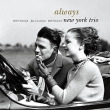 New York Trio, Always (Venus). This is pianist Charlap's other trio, with bassist Jay Leonhart and drummer Bill Stewart rather than his Blue Note companions Peter Washington and Kenny Washington. In his eighth CD for the Japanese label he honors Irving Berlin by lovingly playing the melodies of ten Berlin songs, then improvising on the pieces with inventiveness, harmonic ingenuity and interaction with Leonhart and Stewart. Charlap's keyboard touch and subtle use of dynamics, notable throughout, are captivating in the unaccompanied version of "Russian Lullaby" that ends the album.
New York Trio, Always (Venus). This is pianist Charlap's other trio, with bassist Jay Leonhart and drummer Bill Stewart rather than his Blue Note companions Peter Washington and Kenny Washington. In his eighth CD for the Japanese label he honors Irving Berlin by lovingly playing the melodies of ten Berlin songs, then improvising on the pieces with inventiveness, harmonic ingenuity and interaction with Leonhart and Stewart. Charlap's keyboard touch and subtle use of dynamics, notable throughout, are captivating in the unaccompanied version of "Russian Lullaby" that ends the album.
 Miguel Zenón, Esta Plena (Marsalis Music). The alto saxophonist and composer illuminates and elevates la plena, the peoples' music of his native Puerto Rico. Zenón augments his quartet with percussionists playing pandero, seguidor and requinto drums to provide the music's rhythmic heart. Zenón's playing further establishes him as one of the most important young soloists in jazz. Pianist Luis Perdomo, bassist Hans Glawischnig and drummer Henry Cole are impressive throughout. Zenón aids understanding of the music with a scholarly liner essay tracing the history and cultural importance of la plena.
Miguel Zenón, Esta Plena (Marsalis Music). The alto saxophonist and composer illuminates and elevates la plena, the peoples' music of his native Puerto Rico. Zenón augments his quartet with percussionists playing pandero, seguidor and requinto drums to provide the music's rhythmic heart. Zenón's playing further establishes him as one of the most important young soloists in jazz. Pianist Luis Perdomo, bassist Hans Glawischnig and drummer Henry Cole are impressive throughout. Zenón aids understanding of the music with a scholarly liner essay tracing the history and cultural importance of la plena.
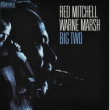 Red Mitchell, Warne Marsh, Big Two (Storyville). Bassist Mitchell (1927-1992) and tenor saxophonist Marsh (1927-1987) played as a duo for two nights in 1980 at the Fasching Club in Stockholm. In this intimate recording, Storyville engineer Nils Edström captured the brilliance and inventiveness of their work. Long unavailable, the 2-CD set captures them at the peak of their powers. Among the highlights: Marsh channeling Lester Young's famous "Lady Be Good" solo, then creating a memorable one of his own, and the two romping through Miles Davis's "Little Willie Leaps."
Red Mitchell, Warne Marsh, Big Two (Storyville). Bassist Mitchell (1927-1992) and tenor saxophonist Marsh (1927-1987) played as a duo for two nights in 1980 at the Fasching Club in Stockholm. In this intimate recording, Storyville engineer Nils Edström captured the brilliance and inventiveness of their work. Long unavailable, the 2-CD set captures them at the peak of their powers. Among the highlights: Marsh channeling Lester Young's famous "Lady Be Good" solo, then creating a memorable one of his own, and the two romping through Miles Davis's "Little Willie Leaps."
 Art Farmer, Live in '64 (Jazz Icons). Farmer's quartet with guitarist Jim Hall was one of the greatest small groups in jazz history. For this television appearance, he featured pieces never released in the quartet's recordings. Among them are an exhilarating "Bilbao Song," Sonny Rollins's "Valse Hot" and Cole Porter's "So in Love." Steve Swallow is the bassist, Pete LaRoca the drummer. Deeply experienced together by this time, the four were breathtaking in their individual and collective performance. The BBC-TV video is crisp, the audio clear. This is a jewel in Jazz Icons' eagerly anticipated fourth release.
Art Farmer, Live in '64 (Jazz Icons). Farmer's quartet with guitarist Jim Hall was one of the greatest small groups in jazz history. For this television appearance, he featured pieces never released in the quartet's recordings. Among them are an exhilarating "Bilbao Song," Sonny Rollins's "Valse Hot" and Cole Porter's "So in Love." Steve Swallow is the bassist, Pete LaRoca the drummer. Deeply experienced together by this time, the four were breathtaking in their individual and collective performance. The BBC-TV video is crisp, the audio clear. This is a jewel in Jazz Icons' eagerly anticipated fourth release.
This is the 92nd anniversary of Dizzy Gillespie's birth. There are many ways to celebrate it. The Rifftides staff offers two. The first video is from the Bern Jazz Festival in 1985. The band is Dizzy, James Moody, Gene Harris, Ray Brown and Grady Tate. The tune is "Ow." It was made famous by the great Gillespie big band of the 1940s. So were Moody and Brown.
The second clip is from the 1979 Newport Jazz Festival in Nice, France. With Gillespie are Arnie Lawrence, alto sax; Stan Getz, tenor sax; John Lewis, piano; George Duvivier, bass; and Shelly Manne, drums. The piece is Ellington's "It Don't Mean a thing if it Ain't Got That Swing."
Jazz On The Tube has strung together nearly a score of Gillespie videos, including his only known TV appearance with Louis Armstrong and his gig with The Muppets. Happy Dizzy's birthday to you.
Let's wrap up the Fall Festival at The Seasons. Here are brief reports about the final four events.
• Africa: The Power of Drum and Dance: Michael Wimberly, a percussionist and composer from New York, performed with scores of sidemen and sidewomen. They were professional drummers, dancers and singers from his troupe;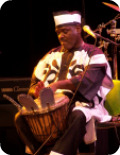 students from several middle schools and high schools; a contingent from the Yakima Valley Community College jazz ensemble; and a band of marimbists, if that's the term, who played marimbas of all sizes from small to preposterously large. Building on traditional African rhythms, Wimberly morphed his flexible supporting cast into several percussion and dance combinations delivering aural and visual excitement that had the audience in a packed house grooving in their seats. It was a spectacle that had the added impact of opening up a hundred or so youngsters to roots music that can enrich their lives. The joy on their faces seemed to show that the process was underway.
students from several middle schools and high schools; a contingent from the Yakima Valley Community College jazz ensemble; and a band of marimbists, if that's the term, who played marimbas of all sizes from small to preposterously large. Building on traditional African rhythms, Wimberly morphed his flexible supporting cast into several percussion and dance combinations delivering aural and visual excitement that had the audience in a packed house grooving in their seats. It was a spectacle that had the added impact of opening up a hundred or so youngsters to roots music that can enrich their lives. The joy on their faces seemed to show that the process was underway.
• The Matt Wilson Quartet. Wilson alone can be a spectacle. Fresh from the cover of Down Beat magazine, the drummer brought to the festival saxophonist Jeff Lederer, trumpeter Kirk Knuffke and bassist Chris Lightcap. Six of their ten pieces were from his most recent CD, That's Gonna Leave a Mark. Their intensity was enhanced by the energy Wilson generates 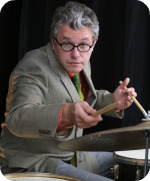 in live performance and transmits to musicians and audience. He kicked off a furious tempo for John Lewis's "Two Bass Hit," a staple of Dizzy Gillespie's 1940s big band. Lederer soloed with essence of Coltrane, Knuffke with impressive thematic development, Lightcap with lyricism, the true wood sound of the bass and (hooray) little volume on his amplifier. Through the evening, Wilson surged, roared and crackled beneath the ensemble and the soloists, a continuously renewable source of power. Other highlights of the set: Lederer coming out of an abstracted arrangement of "Don't Blame Me" into a gorgeous tenor saxophone solo on the tune's changes, then a pure statement of the melody; his wild clarinet solo on "Rear Control;" Knuffke's ability to produce a sound like Chet Baker's one minute and Wadada Leo Smith's the next; The contrast between Wilson's manic shenanigans in a spoof of heavy metal called "Schoolboy Thug" and the peacefulness of the encore, a prayerful ensemble reading of the Scottish Presbyterian hymn "Come and Find the Quiet Center."
in live performance and transmits to musicians and audience. He kicked off a furious tempo for John Lewis's "Two Bass Hit," a staple of Dizzy Gillespie's 1940s big band. Lederer soloed with essence of Coltrane, Knuffke with impressive thematic development, Lightcap with lyricism, the true wood sound of the bass and (hooray) little volume on his amplifier. Through the evening, Wilson surged, roared and crackled beneath the ensemble and the soloists, a continuously renewable source of power. Other highlights of the set: Lederer coming out of an abstracted arrangement of "Don't Blame Me" into a gorgeous tenor saxophone solo on the tune's changes, then a pure statement of the melody; his wild clarinet solo on "Rear Control;" Knuffke's ability to produce a sound like Chet Baker's one minute and Wadada Leo Smith's the next; The contrast between Wilson's manic shenanigans in a spoof of heavy metal called "Schoolboy Thug" and the peacefulness of the encore, a prayerful ensemble reading of the Scottish Presbyterian hymn "Come and Find the Quiet Center."
• Yakima Symphony Chamber Orchestra. In addition to percussionist Wimberly's work with young musicians, the primary educational activity of The Seasons Fall Festival was the development of emerging composers and conductors from all regions of the United States. The composers studied under the guidance of Daron Hagen, Chris Brubeck, Gilda Lyons and Robert Frankenberry. The emerging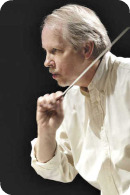 conductors worked with retiring Yakima Symphony Orchestra conductor Brooke Cresswell (pictured) and one of Cresswell's mentors, Donald Thulean, a veteran conductor of several orchestras. The evening began with the world premiere of Cicadas, Lyons' atmospheric evocation of a childhood memory of seventeen-year cicadas swarming. It ended with Hagen's Concerto for Violin, Cello and Orchestra, featuring violinist Simon James and cellist Kevin Krentz. In between, the audience heard the culmination of a week of workshops and rehearsals. Each young conductor led the orchestra in a piece by one of the young composers. The seven new compositions ran about four minutes apeice. They showed enormous potential from a group of musicians, one only 16 years old, whose work should give heart to anyone concerned about the future of serious music in America.
conductors worked with retiring Yakima Symphony Orchestra conductor Brooke Cresswell (pictured) and one of Cresswell's mentors, Donald Thulean, a veteran conductor of several orchestras. The evening began with the world premiere of Cicadas, Lyons' atmospheric evocation of a childhood memory of seventeen-year cicadas swarming. It ended with Hagen's Concerto for Violin, Cello and Orchestra, featuring violinist Simon James and cellist Kevin Krentz. In between, the audience heard the culmination of a week of workshops and rehearsals. Each young conductor led the orchestra in a piece by one of the young composers. The seven new compositions ran about four minutes apeice. They showed enormous potential from a group of musicians, one only 16 years old, whose work should give heart to anyone concerned about the future of serious music in America.
• Dena DeRose. On the eve of her return to Graz, Austria, where she is a professor at the University of Music and Dramatic Arts, the pianist and singer demonstrated her qualifications in both areas. Her playing and singing are musical in the extreme and, when she digs into the rhythm with the zeal she displayed Saturday 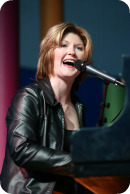 night, dramatic. Matt Wilson and Chris Lightcap joined DeRose for the festival's final concert, creating a trio with extraordinary cohesion and singleness of purpose. There were moments when the three were swinging as hard as any piano trio I have heard. The interaction between Wilson and the pianist was remarkable. DeRose's celebrated improvisation of lines with voice and keyboard in parallel was never a gimmick, the integration so subtle that it took the listener a few seconds to realize what was producing that unique blend of sound. The technique has been used since at least as far back as the great Joe Mooney, but rarely with DeRose's musicianship and finesse. Whether in a standard like "How Deep is the Ocean?" or the relatively unfamiliar ballad "In the Glow of the Moon," DeRose's singing was perfect in pitch, phrasing, interpretation and pleasure in performing. Most of The Seasons audience arrived with little or no previous knowledge of DeRose. They are unlikely to forget the finale that she provided a memorable festival.
night, dramatic. Matt Wilson and Chris Lightcap joined DeRose for the festival's final concert, creating a trio with extraordinary cohesion and singleness of purpose. There were moments when the three were swinging as hard as any piano trio I have heard. The interaction between Wilson and the pianist was remarkable. DeRose's celebrated improvisation of lines with voice and keyboard in parallel was never a gimmick, the integration so subtle that it took the listener a few seconds to realize what was producing that unique blend of sound. The technique has been used since at least as far back as the great Joe Mooney, but rarely with DeRose's musicianship and finesse. Whether in a standard like "How Deep is the Ocean?" or the relatively unfamiliar ballad "In the Glow of the Moon," DeRose's singing was perfect in pitch, phrasing, interpretation and pleasure in performing. Most of The Seasons audience arrived with little or no previous knowledge of DeRose. They are unlikely to forget the finale that she provided a memorable festival.
A small but important part of The Seasons Fall Festival brought a select group of arts supporters to the Greystone Restaurant in Yakima's historic district for an evening of food, wine and entertainment. Daron Hagen served as impresario, pianist and raconteur as soprano Gilda Lyons and tenor Robert Frankenberry performed songs by a who's-who of composers and lyricists. The Seasons Performance Hall is a nonprofit operation that has managed with difficulty to weather the storm and stress of the struggling economy. It depends, like such arts outfits everywhere, on community support and the kindness of donors. The evening was designed to generate tangible help for the organization.
Hagen's montage of pieces by George and Ira Gershwin, Johnny Mercer, Leonard Bernstein, Henry Mancini, Kurt Weill Stephen Sondheim, Jacques Brel, Marc Blitzstein 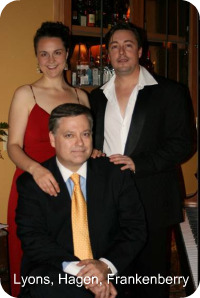 and Joe Raposo was as rich as the Greystone chef's red wine reduction sauce on the steak. Frequent collaborators, Lyons and Frankenberry have developed smooth rapport in voice and dramatic presentation. Sailing along in Hagen's skillful arrangements, they blended segments of disparate musical material into an event that would be at home in tony cabaret establishments of Manhattan, San Francisco or London. Their treatment of material from Weill's and Blitzstein's Threepenny Opera, in a kaleidoscope of styles, began the cabaret at a high level that elevated through the hour. There were those in the elegant Greystone dining room who clearly relished the quality of the performance but, as luck would have it, two tables strategically placed near the front of the room accommodated folks who appeared nonplussed, then disappointed.
and Joe Raposo was as rich as the Greystone chef's red wine reduction sauce on the steak. Frequent collaborators, Lyons and Frankenberry have developed smooth rapport in voice and dramatic presentation. Sailing along in Hagen's skillful arrangements, they blended segments of disparate musical material into an event that would be at home in tony cabaret establishments of Manhattan, San Francisco or London. Their treatment of material from Weill's and Blitzstein's Threepenny Opera, in a kaleidoscope of styles, began the cabaret at a high level that elevated through the hour. There were those in the elegant Greystone dining room who clearly relished the quality of the performance but, as luck would have it, two tables strategically placed near the front of the room accommodated folks who appeared nonplussed, then disappointed.
Several of the women who occupied one of the tables stayed through most of the performance, shooting one another puzzled glances. The men who sat at the other walked out one by one and, by the end, left the table empty and the room a bit chilled. I don't know what they were expecting, but evidently it was not the sophisticated production Hagen, Lyons and Frankenberry gave them. Too bad for them, but I hope not too bad for The Seasons because it needs the support not only of ticket buying concert-goers but also of wealthy and influential citizens. I wonder whether in retrospect the festival organizers wish that they had made the cabaret a public event. With proper sound and lighting in the intimate, acoustically perfect atmosphere of The Seasons hall, it might have gone further toward achieving their goal.
The next Rifftides post will be a wrap-up of the festival's final events, which included stirring concerts by Matt Wilson and Dena DeRose and an evening that presented no fewer than nine world premieres by seven young and two seasoned (ahem) composers.
There was a sneak peak of the--for lack of a more accomodating word--classical aspects of The Seasons Fall Festival when tenor Robert Frankenberry and soprano Gilda Lyons previewed a bit of Daron Hagen's opera Amelia. The Seattle Opera will premiere the work next spring. At an intimate session in The Seasons back room, the New York composer talked about the opera, which is in gestation, then took to the piano to accompany Frankenberry and Lyons in an aria. The Amelia of the title is not the lost pilot Amelia Earhart but the daughter of a Navy flyer who died in the Viet Nam war. The libretto by the poet Gardner McFall is based on the wartime loss of her own father. The work, as described by Hagen, has a complexity of themes involving flight, including references to Earhart and the myth of Icarus and Daedalus. If the entire opera is as beautiful as the sample, it will be worth the trip to Seattle in May.
New York composer talked about the opera, which is in gestation, then took to the piano to accompany Frankenberry and Lyons in an aria. The Amelia of the title is not the lost pilot Amelia Earhart but the daughter of a Navy flyer who died in the Viet Nam war. The libretto by the poet Gardner McFall is based on the wartime loss of her own father. The work, as described by Hagen, has a complexity of themes involving flight, including references to Earhart and the myth of Icarus and Daedalus. If the entire opera is as beautiful as the sample, it will be worth the trip to Seattle in May.
Hagen, the festival's artistic director, put together a sampler concert in the main hall that previewed many elements of the festival's nine days. It encompassed performances by the Finisterra Piano Trio, the Kairos String Quartet, Chris Brubeck, the African percussion expert Michael Wimberly, more singing by Lyons and Frankenberry and a performance by Frankenberry of Aaron Copland's 1931 Piano Variations. The Copland piece begins as a puzzling series of abstractions from his most experimental period. It works through 20 nervous, kinetic variations to a coda that ends the work in a grand  statement packed with harmonic riches. It is notoriously demanding to play and, for many, difficult to listen to. Leonard Bernstein used to say that he could wind up a party with it because it would empty the room in two minutes. This recording is probably the best one available, but Rob Frankenberry should put it on a CD because--there's no better way to describe it--he plays the hell out of it.
statement packed with harmonic riches. It is notoriously demanding to play and, for many, difficult to listen to. Leonard Bernstein used to say that he could wind up a party with it because it would empty the room in two minutes. This recording is probably the best one available, but Rob Frankenberry should put it on a CD because--there's no better way to describe it--he plays the hell out of it.
The "Bravi Tutti" sampler evening ended with a new Hagen arrangement of "Amazing Grace" played by all of the evening's 20 or so musicians. Brooke Creswell, the retiring music director of the Yakima Symphony Orchestra, played double bass, Chris Brubeck worked up a long, blowsy, trombone solo and the Finisterra's Tanya Stambuck brought down the house with her vigorous interpretation of the solo piano section.
The next evening's chamber music concert by Kairos and Finisterra had riches of several eras. It included works by composers Michael Torke, Felix Mendelssohn, André Previn, Bedřich Smetana and a deeply felt short string quartet piece by Hagen, Snapshot no. 1: Wedding Day. It ended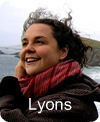 with the Finisterra Trio's world premiere performance of Gilda Lyons' Folklorico, commissioned by The Seasons for this festival. The four-part piece is based on music and folklore of Nicaragua. It abounds with passions and rhythms of Latin America and a slow section called "Tortuga's Lament" so intriguing that I am ready to immediately hear it again.
with the Finisterra Trio's world premiere performance of Gilda Lyons' Folklorico, commissioned by The Seasons for this festival. The four-part piece is based on music and folklore of Nicaragua. It abounds with passions and rhythms of Latin America and a slow section called "Tortuga's Lament" so intriguing that I am ready to immediately hear it again.
More later on an evening of cabaret, an African drum spectacular, the dynamo known as Matt Wilson and the Dena DeRose trio, which, as this is written, I am off to hear. Stay
tuned.
The next night (see the following exhibit) in their own concert, the Imani Winds drew upon music from their CD The Classical Underground. They began with the late Astor Piazzolla's Libertango, a brief example of the heterodoxy with which Piazzolla shocked and outraged the Argentine tango establishment and ultimately endeared himself to music lovers everywhere. The Imani French horn player, Jeff Scott, arranged the piece to feature his instrument's dramatic, even explosive, qualities. From a different branch of Latin music, the woodwind quintet continued with composer Paquito D'Rivera's Aires Tropicales, a seven-part suite illuminated by the insinuating movement called "Dizzyness" (after D'Rivera's former boss Dizzy Gillespie) and the magnetic harmonies of a joropo, "Vals Venezolano."
upon music from their CD The Classical Underground. They began with the late Astor Piazzolla's Libertango, a brief example of the heterodoxy with which Piazzolla shocked and outraged the Argentine tango establishment and ultimately endeared himself to music lovers everywhere. The Imani French horn player, Jeff Scott, arranged the piece to feature his instrument's dramatic, even explosive, qualities. From a different branch of Latin music, the woodwind quintet continued with composer Paquito D'Rivera's Aires Tropicales, a seven-part suite illuminated by the insinuating movement called "Dizzyness" (after D'Rivera's former boss Dizzy Gillespie) and the magnetic harmonies of a joropo, "Vals Venezolano."
To these ears, predisposed by years of living in New Orleans, the evening's highlight was a short piece by another composer seasoned under the tutelage and leadership of Gillespie. It was Lalo Schifrin's La Nouvelle Orleans, a seven-minute sketch that combines Schifrin's classical and jazz sensibilities to encapsulate the sadness and liberating joy of a traditional New Orleans funeral procession. The Imanis, virtuosos all, captured both aspects as if they had often experienced the emotions of that march to and from the cemetery. Torin Spellman-Diaz, the oboist in the group photo above, was  unable to be in Yakima. Her substitute, able and fully engaged, was James Roe (pictured), a stalwart of the New York chamber music milieu. To see bios and more photos of the regular members of the group, go here.
unable to be in Yakima. Her substitute, able and fully engaged, was James Roe (pictured), a stalwart of the New York chamber music milieu. To see bios and more photos of the regular members of the group, go here.
More about the festival is on the way, maybe later today.
This festival has so many elements that it fits in only one category, Music. Its jazz, classical, cabaret, and percussion aspects have flowed in an outpouring of music that blends in a steam of consciousness experience for the listener. All of the events have been public except for one intimate gathering designed to entice deep-pockets supporters to assure this unusual festival's future.
The performance that has so far most dramatically expressed the eclectic vision of the festival's founders was a live version of a three-part suite first heard on a Brubeck Brothers Quartet CD. The album is called Classified, but 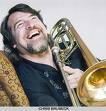 composer Chris Brubeck's "Vignettes for Nonette" is unclassifiable. It combined the Brubeck Brothers band with the Imani Winds, a woodwind quintet of classical musicians who understand swinging. The technical complexity of Brubeck's writing is leavened with drama, humor and--notably in the second movement--grandeur. It has sections of improvisation for the jazz quartet and, this being a Brubeck work, challenging time signatures. The Seasons audience was brought to its feet cheering the emotion and wit of the music, the verve and obvious enjoyment of the nine players and the power of Dan Brubeck's drumming in the final movement. Programming the concert, the Brubecks were wise to combine with the Imanis in the second set. Impressive as the Brubeck brothers, pianist Chuck Lamb and guitarist Mike DeMicco were before intermission, it would have been tough to follow the collaboration with Imani on "Vignettes" and their rousing combined-forces encore, Dave Brubeck's "Blue Rondo a la Turk."
composer Chris Brubeck's "Vignettes for Nonette" is unclassifiable. It combined the Brubeck Brothers band with the Imani Winds, a woodwind quintet of classical musicians who understand swinging. The technical complexity of Brubeck's writing is leavened with drama, humor and--notably in the second movement--grandeur. It has sections of improvisation for the jazz quartet and, this being a Brubeck work, challenging time signatures. The Seasons audience was brought to its feet cheering the emotion and wit of the music, the verve and obvious enjoyment of the nine players and the power of Dan Brubeck's drumming in the final movement. Programming the concert, the Brubecks were wise to combine with the Imanis in the second set. Impressive as the Brubeck brothers, pianist Chuck Lamb and guitarist Mike DeMicco were before intermission, it would have been tough to follow the collaboration with Imani on "Vignettes" and their rousing combined-forces encore, Dave Brubeck's "Blue Rondo a la Turk."
Later today, I'll post more on the festival, including something about that private event, if car shopping and rehearsal time allow. I've been drafted to do a reading and fool around on trumpet with Matt Wilson's quartet at tonight's concert.
The Portland Jazz Festival today announced its 2010 headliners and beefed up its front office strength by adding a veteran jazz publicist as managing director.
 The headliners for the February 22-28 festival will be Pharoah Sanders (pictured), Luciana Souza, Dave Douglas, Dave Holland and the Mingus Big Band. There will also be concerts by three Norwegian groups. They are the saxophone-accordian duo of Trygvie Seim and Frode Haltli, the Christian Wallumrod Ensemble and In The Country, a trio of acoustic bass, piano and drums that, according to the festival's publicity, combines rock influences with jazz. That's not a revolutionary idea, but maybe they have a new slant.
The headliners for the February 22-28 festival will be Pharoah Sanders (pictured), Luciana Souza, Dave Douglas, Dave Holland and the Mingus Big Band. There will also be concerts by three Norwegian groups. They are the saxophone-accordian duo of Trygvie Seim and Frode Haltli, the Christian Wallumrod Ensemble and In The Country, a trio of acoustic bass, piano and drums that, according to the festival's publicity, combines rock influences with jazz. That's not a revolutionary idea, but maybe they have a new slant.
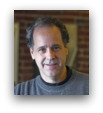 Don Lucoff, who has for more than two decades run the extensive publicity agency DL Media, will take over as the festival's managing director, working with its founder and artistic director, Bill Royston. For details about the artists and Lucoff, see the PDX web site.
Don Lucoff, who has for more than two decades run the extensive publicity agency DL Media, will take over as the festival's managing director, working with its founder and artistic director, Bill Royston. For details about the artists and Lucoff, see the PDX web site.
Speaking of festivals, I'm moving at a fast pace battling car trouble and trying to keep up with The Seasons Fall Festival, now in its sixth day. I promised reports, and they will come, possibly beginning as soon as late tonight. The variety and quality have been impressive.
Speaking of Dena DeRose (see the October 9 item below), she just showed up in YouTube clips accompanying and soloing with Bill Henderson at this summer's Litchfield Jazz Festival. Listen to the head of steam the quartet generates on "You Are My Sunshine." Avery Sharpe is the bassist, Winard Harper the drummer.
To hear three more songs from that occasion, go here and scroll down to the middle of the screen.
Sorry for the short notice, but this just came in from Jovino Santos Neto. The program he tells us about will go on the air ten minutes from now as I write this at 12:50 pm PDT.
Jim Wilke, who has become a Northwest musical icon for his relentless support of our music scene for decades. His show Jazz Northwest is a sampling of the music that happens around here, and "Jazz After Hours" keeps good company to all those who love music throughout the weekend nights. Jim is having a fund drive for his show today, Sunday from 1 to 2 PM at KPLU, 88.5 FM. I encourage you to call 1-800-677-5787 during that time or go online anytime at www.kplu.org and donate what you can to keep his show going. Make sure you specify Jim Wilke's show as a recipient of your generosity. His show is the only one on the station that fully supports the world-class music that flows from this region to the world. Now it's the time to us to give back.
To hear JIm's program, go here. Please consider supporting this important music broadcaster. Here's a link to his invaluable Jazz After Hours. But the important thing right now is to help assure the future of Jazz Northwest.
For the next several days, blogging will be irregular. ("So, what's new?" a cynic might say.) The Rifftides staff is knee deep in the fourth year of The Seasons Fall 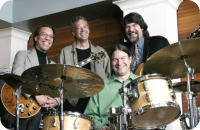 Festival. The nine days of music include The Brubeck Brothers Quartet (pictured, left), Matt Wilson, Dena DeRose, The Imani Winds (pictured below), an African drum ensemble and an assortment of piano trios, string quartets and a chamber orchestra. The festival will present the world premiere of a new work by composer Daron Hagen, the festival's artistic director. To see a schedule of the main events, go here.
Festival. The nine days of music include The Brubeck Brothers Quartet (pictured, left), Matt Wilson, Dena DeRose, The Imani Winds (pictured below), an African drum ensemble and an assortment of piano trios, string quartets and a chamber orchestra. The festival will present the world premiere of a new work by composer Daron Hagen, the festival's artistic director. To see a schedule of the main events, go here.
Parallel to the festival's main concerts is a series of workshops conducted by Hagen for a 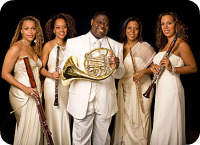 dozen outstanding young composers from around the United States. The Yakima Symphony Chamber Orchestra under Brooke Creswell will perform two new compositions chosen from among those by the young composers. All of that in a town of 85,000 in the heart of apple country at the foot of the Cascade mountains. That's lot of music, a lot of listening. I will post reviews and impressions along the way. The satellite events will include a Monday pre-concert music-and-gab session conducted by your faithful correspondent. For a detailed schedule of all the events, go here. If you are coming to Yakima for the festival, please make yourself known. I'd enjoy meeting you.
dozen outstanding young composers from around the United States. The Yakima Symphony Chamber Orchestra under Brooke Creswell will perform two new compositions chosen from among those by the young composers. All of that in a town of 85,000 in the heart of apple country at the foot of the Cascade mountains. That's lot of music, a lot of listening. I will post reviews and impressions along the way. The satellite events will include a Monday pre-concert music-and-gab session conducted by your faithful correspondent. For a detailed schedule of all the events, go here. If you are coming to Yakima for the festival, please make yourself known. I'd enjoy meeting you.
A friend asked me to bicycle through the Yakima River canyon with him this morning. I said I had too much work to do, so he rode the 40 miles north to Ellensburg alone. When he got back, he sent a message, "The canyon is nice today," with evidence.
 Trumpeter Marcus Belgrave, admired within jazz circles but little known outside them, has received tangible recognition for his work as a player and a teacher. Belgrave left Ray Charles in the early 1960s ago to settle in Detroit. In today's Detroit Free Press, Mark Stryker reports on the award and on Belgrave's contribution to the city's cultural life. Stryker writes:
Trumpeter Marcus Belgrave, admired within jazz circles but little known outside them, has received tangible recognition for his work as a player and a teacher. Belgrave left Ray Charles in the early 1960s ago to settle in Detroit. In today's Detroit Free Press, Mark Stryker reports on the award and on Belgrave's contribution to the city's cultural life. Stryker writes:
For 46 years, Belgrave's world-class musicianship, charisma, swing and commitment to mentoring young musicians -- many of whom have become stars -- have made Detroit a hipper city than it would have been without him.
To read the whole thing and hear a Belgrave performance with Tommy Flanagan's trio, go here.
This video profile by Bret Primack supplements Stryker's column.
For more of Primack's profiles, go here.
Marc Myers, the resourceful and indefatigable king of the verbatim interview, posts a JazzWax conversation with Sonny Rollins about one of Rollins's most unusual and successful albums. An excerpt:
JW: How did you pick the songs?SR: All the songs I knew. By going to the movies so much as a child in the 30s, I was tuned in to Western popular music themes. Even today, people credit me for having an encyclopedic knowledge of what's called the American Songbook. Included in there are Western songs, and Country music, too. When I was offered the date by Les (Koenig), I said, "Let's make a concept album about the West," which would evoke my feelings and the whole Western thing.
Rollins talks about how the famous William Claxton cover photo in the desert came about, and whose idea it was. To get the whole story, go here.
Brand New: In Brief
Joe Martin, Not By Chance (Anzic). Martin is a versatile and rounded bassist who has 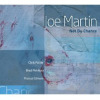 collaborated with a wide range of musicians at the heart of the 30-something generation of jazz players in New York. Here, he enlists two fellow members of that generation's elite, pianist Brad Mehldau and saxophonist and clarinetist Chris Potter. The drummer, several years younger, is Marcus Gilmore, an accompanist who listens, reacts and adjusts. All of the tunes but Jaco Pastorius's "The Balloon Song" are Martin's. The compositions and the performers radiate assurance and peacefulness regardless of tempo or harmonic challenge, yet there's not a hint of complacency. For all its loveliness, this is music that energizes the listener's imagination.
collaborated with a wide range of musicians at the heart of the 30-something generation of jazz players in New York. Here, he enlists two fellow members of that generation's elite, pianist Brad Mehldau and saxophonist and clarinetist Chris Potter. The drummer, several years younger, is Marcus Gilmore, an accompanist who listens, reacts and adjusts. All of the tunes but Jaco Pastorius's "The Balloon Song" are Martin's. The compositions and the performers radiate assurance and peacefulness regardless of tempo or harmonic challenge, yet there's not a hint of complacency. For all its loveliness, this is music that energizes the listener's imagination.
E.J.Strickland, In This Day (Strick Musik). Like Marcus Gilmore, drummer Strickland is elastic in his approach to rhythm. In this album of his compositions, he drives the music while accommodating the  idiosyncrasies and divergent approaches of his horn players, pianist and bassist. The sidemen are his twin brother Marcus, a resourceful tenor and soprano saxophonist; the increasingly impressive alto saxophonist Jaleel Shaw; pianist Luis Perdomo; and bassist Hans Glawischnig. The latter two are regular members of alto saxophonist Miguel Zenon's band. An assortment of guests is employed on various tracks for atmosphere and a couple of spoken-word episodes that are weak poetry. The quintet provides the primary interest, and it was all Strickland needed except for Pedro Martinez's congas on the Latin pieces, Tia Fuller's winsome flute on "Illusions" and a reflective guitar interlude by David Gilmore on "Robin." The saxophones achieve a lovely blend on "Enternal," managing to convey with their different pitches alone a sense of harmonization. "New Beginnings" is a particularly effective Strickland composition, with Strickland and Martinez laying down a shifting percussion foundation for eloquent solos by Perdomo and the saxophonists. It is a balanced and thoughtful album.
idiosyncrasies and divergent approaches of his horn players, pianist and bassist. The sidemen are his twin brother Marcus, a resourceful tenor and soprano saxophonist; the increasingly impressive alto saxophonist Jaleel Shaw; pianist Luis Perdomo; and bassist Hans Glawischnig. The latter two are regular members of alto saxophonist Miguel Zenon's band. An assortment of guests is employed on various tracks for atmosphere and a couple of spoken-word episodes that are weak poetry. The quintet provides the primary interest, and it was all Strickland needed except for Pedro Martinez's congas on the Latin pieces, Tia Fuller's winsome flute on "Illusions" and a reflective guitar interlude by David Gilmore on "Robin." The saxophones achieve a lovely blend on "Enternal," managing to convey with their different pitches alone a sense of harmonization. "New Beginnings" is a particularly effective Strickland composition, with Strickland and Martinez laying down a shifting percussion foundation for eloquent solos by Perdomo and the saxophonists. It is a balanced and thoughtful album.
Oldish: Less Brief
Eric Felten, T-Bop (Soul Note). Conducting research, I came across this first album by the trombonist.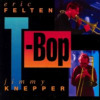 Somehow, it got by me when it was released in 1993. Not long out of graduate school when he recorded it, Felten made his debut in the heavy, even intimidating, trombone company of Jimmy Knepper (1927-2003), one of the great unconventional thinkers and players among improvising musicians. On some tracks, the third horn is a tenor saxophone played by Joshua Redman barely known when the album was made in 1992. He was a Harvard friend of Felten. Redman's own first album
Somehow, it got by me when it was released in 1993. Not long out of graduate school when he recorded it, Felten made his debut in the heavy, even intimidating, trombone company of Jimmy Knepper (1927-2003), one of the great unconventional thinkers and players among improvising musicians. On some tracks, the third horn is a tenor saxophone played by Joshua Redman barely known when the album was made in 1992. He was a Harvard friend of Felten. Redman's own first album 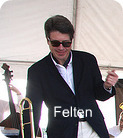 come out the following year. The rhythm section was pianist Jonny King, bassists Paul Henry or Paul LaDuca and drummer Jorge Rossy, emerging Boston-area musicians roughly Felten's age. King's boppish work here made me decide to go back and pay closer attention to some of his own recordings. Rossy is noted for his association with pianist Brad Mehldau and as the unofficial house drummer for Fresh Sound Records.
come out the following year. The rhythm section was pianist Jonny King, bassists Paul Henry or Paul LaDuca and drummer Jorge Rossy, emerging Boston-area musicians roughly Felten's age. King's boppish work here made me decide to go back and pay closer attention to some of his own recordings. Rossy is noted for his association with pianist Brad Mehldau and as the unofficial house drummer for Fresh Sound Records.
More or less in the J.J. Johnson camp, Felten contrasts with Knepper's languid trickiness, although at moments he seems inclined to emulate it. With one of the most tromboney of trombonists standing by as he solos, if Felten is a tad nervous, well, who wouldn't be? In any case, they sound as if they're having the time of their lives. The joy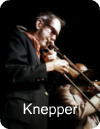 of their counterpoint in the last chorus of "T-Bop" is infectious. Over the intervening 17 years, Redman's work has taken on sophistication and complexity. Here, he wears simplicity and directness on his sleeve. His earnestness is refreshing. All of the pieces but "Stella By Starlight" and "I Guess I'll Hang My Tears Out to Dry" are by Felten the developing composer. "On Second Thought" is an amusingly fractured line on "I Got Rhythm" changes, "Hold Back the Dawn" a brooding ballad worthy of a good lyric. "Deconstruction" is a minor exercise with Latin tendencies that encourages the musicians, particularly Redman, to take their solos to the border of free playing. "Ontology" is a questioning blues line appropriate to its title. There is no question about "Blues for Lester Dubree;" it's down-home and funky and kicks off with a Louis Armstrong quote. "Delphi" would have been at home in Art Blakey's Jazz Messengers book.
of their counterpoint in the last chorus of "T-Bop" is infectious. Over the intervening 17 years, Redman's work has taken on sophistication and complexity. Here, he wears simplicity and directness on his sleeve. His earnestness is refreshing. All of the pieces but "Stella By Starlight" and "I Guess I'll Hang My Tears Out to Dry" are by Felten the developing composer. "On Second Thought" is an amusingly fractured line on "I Got Rhythm" changes, "Hold Back the Dawn" a brooding ballad worthy of a good lyric. "Deconstruction" is a minor exercise with Latin tendencies that encourages the musicians, particularly Redman, to take their solos to the border of free playing. "Ontology" is a questioning blues line appropriate to its title. There is no question about "Blues for Lester Dubree;" it's down-home and funky and kicks off with a Louis Armstrong quote. "Delphi" would have been at home in Art Blakey's Jazz Messengers book.
Felten has gone on to refine his trombone playing, lead a big band in Washington, DC, develop as a singer, publish a book and write a general-interest column in The Wall Street Journal. His second CD included Joe Lovano, Randy Brecker and Bob Mintzer. His tribute to Mel Tormé and Marty Paich featured a who's-who of west coast jazz stars, among them Herb Geller and Jack Sheldon. T-Bop is evidently rare as a physical object but available as an MP3 download. If you missed it the first time around, as I did, you may want to investigate it.
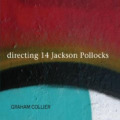 Graham Collier, directing 14 Jackson Pollocks (GCM). Long before he wrote his recent book, Graham Collier's music made it plain that Duke Ellington, Charles Mingus and Gil Evans were profound influences on his work. Collier followed Ellington's and Mingus's lead in fashioning pieces with his soloists in mind rather than the common concept of arrangements into which a leader could plug whatever soloist was at hand. As for Evans, I must say that I heard in Collier's earlier recordings more of the Evans of "La Nevada" or "El Matador" - roiling, abstract patterns under soloists -- than of the tonal tapestries in, say, Sketches of Spain. I still do. Collier amalgamated his inspirations into an orchestral style that coalesced at a moment in the late 1960s when musicians and listeners in Great Britain were ready to expand their ideas about what constituted jazz.
Graham Collier, directing 14 Jackson Pollocks (GCM). Long before he wrote his recent book, Graham Collier's music made it plain that Duke Ellington, Charles Mingus and Gil Evans were profound influences on his work. Collier followed Ellington's and Mingus's lead in fashioning pieces with his soloists in mind rather than the common concept of arrangements into which a leader could plug whatever soloist was at hand. As for Evans, I must say that I heard in Collier's earlier recordings more of the Evans of "La Nevada" or "El Matador" - roiling, abstract patterns under soloists -- than of the tonal tapestries in, say, Sketches of Spain. I still do. Collier amalgamated his inspirations into an orchestral style that coalesced at a moment in the late 1960s when musicians and listeners in Great Britain were ready to expand their ideas about what constituted jazz.
Collier was his own bassist for years before he concentrated entirely on composing, arranging and leading. Among the members of his bands were adventurous players including saxophonists John Surman and Art Themen, trumpeters Kenny Wheeler and Harry Beckett and drummer John Marshall. In directing 14 Jackson Pollocks, Collier reaches distillation of the notion that the orchestra, the written music and the improvising soloist comprise a trinity, each element inseparable from the other. The music makes obvious what the CD title means, unless you don't know who Jackson Pollock was. The two-CD set consists of music recorded at concerts in London in 1997 and 2004. The astonishing Beckett, Themen and Marshall are among the players, along with pianist Roger Dean, bassist Jeff Clyne and others who long since absorbed Collier's ethos of individual independence amidst collective dependence.
arranging and leading. Among the members of his bands were adventurous players including saxophonists John Surman and Art Themen, trumpeters Kenny Wheeler and Harry Beckett and drummer John Marshall. In directing 14 Jackson Pollocks, Collier reaches distillation of the notion that the orchestra, the written music and the improvising soloist comprise a trinity, each element inseparable from the other. The music makes obvious what the CD title means, unless you don't know who Jackson Pollock was. The two-CD set consists of music recorded at concerts in London in 1997 and 2004. The astonishing Beckett, Themen and Marshall are among the players, along with pianist Roger Dean, bassist Jeff Clyne and others who long since absorbed Collier's ethos of individual independence amidst collective dependence.
The music has something in common with the free jazz that emerged in the United States in the sixties, but where free jazz often fell by the weight of its pretensions of liberation from guidelines, Collier's coalesces around his frameworks. His composing and arranging dictates, or suggests, shape, harmonic character and rhythmic direction of the solos. He infuses much of his music with wry humor at which titles like "Between a Donkey and a Rolls Royce" and "An Alternate Low Circus Ballad" can only hint. In any case, humor is only an element In Collier's work, important but minor. He produces serious music that makes demands on its listeners and gives generous compensation to those who welcome it on its terms.
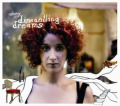 Efrat Alony, Alony (Enja). Bob Brookmeyer called my attention to this Israeli singer who has had success in Germany's avant circles. In Brookmeyer's words, "She is very gifted and very motivated--into electronics, arranging, always composing her own stuff. Been in Berlin for 15 years." He thinks she deserves wider exposure. After spending a couple of hours of a long motor trip with her CD, I agree.
Efrat Alony, Alony (Enja). Bob Brookmeyer called my attention to this Israeli singer who has had success in Germany's avant circles. In Brookmeyer's words, "She is very gifted and very motivated--into electronics, arranging, always composing her own stuff. Been in Berlin for 15 years." He thinks she deserves wider exposure. After spending a couple of hours of a long motor trip with her CD, I agree.
Alony's voice, round and spacious, sounds classically trained. It is in the mezzo range, although she sometimes takes it higher, maintaining fullness and pitch unless she is purposely bending notes, which she occasionally does to great effect. The songs on Alony are not standards; she wrote most of the lyrics and music, with contributions from pianist Mark Reinke and one piece from the Israeli songwriter-singer Etti Ankri. In addition, Alony set to music William Butler Yeats' bittersweet poem, "To a Child Dancing in the Wind." Reinke and drummer Christian Thomé are the primary accompanists. They also provide electronic effects. A string quartet contributes backing and atmospherics. Alony now and then overdubs voices in unison or counterpoint. There's a lot going on, but it's all integrated, allowing concentration on the music as a whole. At their best, Alony's lyrics achieve a haiku-like sensibility that distinguishes superior art songs:
Recollecting
fading shadows of joy
I slowly unlock the shackles of thought
my safeguard
freeing feelings I lost
bewitchment
delight
sweet longing
You are unlikely to find Alony at your corner record store. It is available as a download from Amazon and, evidently, as a CD only from the Enja web site. YouTube has a clever promotional video of "Lights On/Off," the song that opens the album.
I'm not sure that there is a category for what Alony does. I'm not sure that there should be. Call it music.
We'll have more Recent Listening soon. Well, reasonably soon.
From the Wikipedia entry about the saxophonist known as Kenny G:
In 1997, Kenny G earned a place in the Guinness Book of World Records for playing the longest note ever recorded on a saxophone. Kenny G held an E-flat for forty five minutes and 47 seconds in the Hopkins-Bright Auditorium (named after his two friends) at J&R Music World in New York City.
What a treat that must have been.
We'll have to settle for a minute and twenty seconds of A-flat from Harry Carney.
The interested onlooker was Johnny Hodges, so fascinated that he almost forgot to join the ensemble for the big finish.
Have a good weekend.
This is the worst day of my life. Now I have nothing to live for. - Harry Carney on the death of Duke Ellington
Harry Carney died of bereavement. - Whitney Balliett
AJ Ads
AJ Blogs
AJBlogCentral | rssculture
Terry Teachout on the arts in New York City
Andrew Taylor on the business of arts & culture
rock culture approximately
Laura Collins-Hughes on arts, culture and coverage
Richard Kessler on arts education
Douglas McLennan's blog
Dalouge Smith advocates for the Arts
Art from the American Outback
Chloe Veltman on how culture will save the world
For immediate release: the arts are marketable
No genre is the new genre
David Jays on theatre and dance
Paul Levy measures the Angles
Judith H. Dobrzynski on Culture
John Rockwell on the arts
innovations and impediments in not-for-profit arts
Jan Herman - arts, media & culture with 'tude
dance
Apollinaire Scherr talks about dance
Tobi Tobias on dance et al...
jazz
Howard Mandel's freelance Urban Improvisation
Focus on New Orleans. Jazz and Other Sounds
Doug Ramsey on Jazz and other matters...
media
Jeff Weinstein's Cultural Mixology
Martha Bayles on Film...
classical music
Fresh ideas on building arts communities
Greg Sandow performs a book-in-progress
Harvey Sachs on music, and various digressions
Bruce Brubaker on all things Piano
Kyle Gann on music after the fact
Greg Sandow on the future of Classical Music
Norman Lebrecht on Shifting Sound Worlds
Joe Horowitz on music
publishing
Jerome Weeks on Books
Scott McLemee on books, ideas & trash-culture ephemera
theatre
Wendy Rosenfield: covering drama, onstage and off
visual
Public Art, Public Space
Regina Hackett takes her Art To Go
John Perreault's art diary
Lee Rosenbaum's Cultural Commentary

